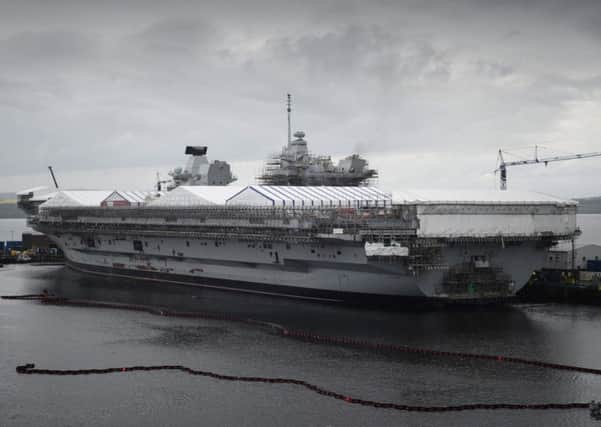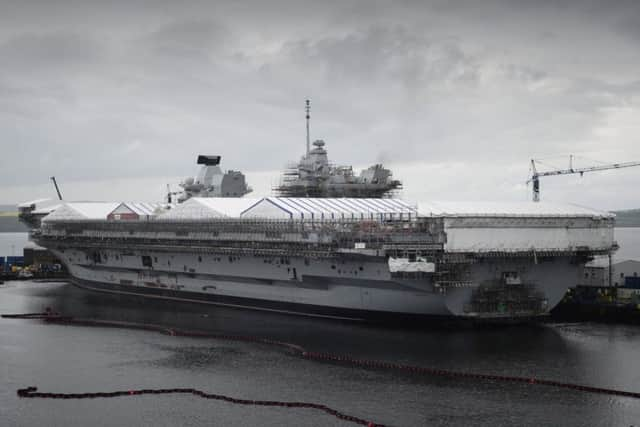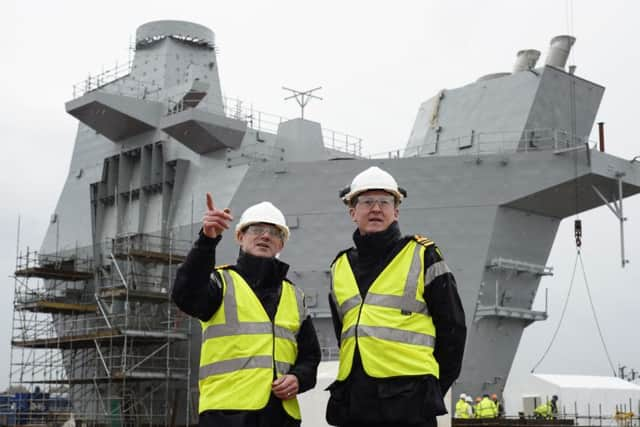Inside the navy's mighty new carriers


And with just a year until the Royal Navy’s newest aircraft carrier HMS Queen Elizabeth comes to Portsmouth, The News was given access to see inside the largest warship ever built in Britain.
The 65,000-tonne leviathan is due to begin her sea trials early next year and could be used as the latest weapon in the battle against murderous terrorists from the so-called Islamic State.
Advertisement
Hide AdAdvertisement
Hide AdSpeaking to The News, Captain Simon Petitt, senior naval officer of Queen Elizabeth, said the flagship would provide four acres of military territory for the UK to wage war from, if it needed to.


‘This will certainly add enormous punch to the capability that we have got and an enormous punch to the capability that the Royal Navy has,’ he said.
Speaking of whether the carrier could be used to destroy Isil, Captain Petitt added: ‘I could certainly see it fighting against the Isil of the future.
‘If you imagine the Gulf War and the Americans putting aircraft carriers deep into Iraq to bomb Hussain’s bunkers and strategic targets, we could do that.
Advertisement
Hide AdAdvertisement
Hide Ad‘If you imagine Sierra Leone where we dropped Royal Marines onto the beaches we could do that.


‘If you can imagine Libya where we had Apache dealing with the more tactical targets near the beach – we could do that as well.
‘So it’s all about flexibility and lots of different missions, that’s what the carrier offers.’
Queen Elizabeth and her sister ship HMS Prince of Wales are the biggest vessels ever built for the Royal Navy.
Advertisement
Hide AdAdvertisement
Hide AdThe ships are each equipped with the latest war-fighting technology, from the state-of-the-art Artisan 3D radar system able to track thousands of objects from hundreds of miles away, to the latest fighter-jets, the F35B Lightning II.


When fully operational, each ship could carry some 40 embarked aircraft, which could include upwards of 30 of the new jets, and could, if needed, act as an air traffic control hub for a small country.
More than 15,500 miles of electrical cabling and fibre-optic wiring have been installed on Queen Elizabeth which will act as the ship’s nerve centre.
Likewise, a vast amount of her war-fighting systems are either in place or not far from being fully operational.
Advertisement
Hide AdAdvertisement
Hide AdHer expansive flight deck, which is almost the size of three football pitches, is now the focus of much of the works.


Yesterday saw some of the first coating of a new space-age, heat-resistant metal being fitted to the flagship’s flight deck.
It’s similar to the coating used to protect Nasa’s space shuttles from the searing heat as they re-enter the earth’s atmosphere.
Using a combination of aluminium and titanium, it can withstand temperatures of 1,500°C – perfect to protect the ship’s deck from the heat generated by the thrust of the F35B’s vertical landing engines.
Advertisement
Hide AdAdvertisement
Hide AdA specially developed robotic spray, which fires powdered metal through a jet of plasma at temperatures of almost 10,000C, blasts the metal to the deck.
Ian Booth, managing director of the Aircraft Carrier Alliance, which is leading the build of the carriers, said this would ensure the ship would operate for the next 50 years.
The ship is due to arrive in Portsmouth in May 2017.
The first trial with the new jets will take place a year later in America.
She will be in service until 2070.
Carrier will transform the way navy operates
‘IT’S the job of a lifetime and the biggest of my career’ – that’s the view of a sailor from Lee-on-the-Solent who is serving on HMS Queen Elizabeth.
Advertisement
Hide AdAdvertisement
Hide AdCommander Steve Prest, 40, is the weapon engineer officer on the nation’s new flagship aircraft carrier.
The 40-year-old recently arrived in Rosyth and will be part of the 700-strong ship’s company when she enters Portsmouth next year.
The proud dad-of-one, who joined the navy 17 years ago, said: ‘The moment we sail into Portsmouth will be incredible.
‘It’s going to be a huge privilege. We’re all really excited.
Advertisement
Hide AdAdvertisement
Hide Ad‘There isn’t a single one of us who doesn’t want to be there and I think frankly a lot of our friends will be pretty jealous.
‘This ship is making history and to be a part of that is a honour and a privilege.’
Commander Prest is one of 550 ship’s company already based in Scotland learning all the nuances of the titanic warship.
His role will see him leading the weapons engineering department of Queen Elizabeth – a big role, but one he says he is not daunted by.
Advertisement
Hide AdAdvertisement
Hide Ad‘I’m not anxious about my role because I’ve got a great team with me,’
Commander Prest, who previously served aboard HMS Sutherland and HMS Richmond, said Portsmouth was the perfect home for the navy’s most advanced warship.
‘He added: These ships are going to transform the way the navy operates and Portsmouth is playing a crucial part in that.
‘It’s exciting to be a part of that.’
She’s a building site... but she’s coming alive
IT WAS a dank and dismal day as my plane landed on the tarmac at Edinburgh Airport.
Advertisement
Hide AdAdvertisement
Hide AdRain was lashing down in relentless sheets and the sky was a dark, depressing grey.
I was welcomed by a representative from defence giant BAE Systems, who led me to my coach for the short 15-minute journey to Rosyth.
My first glimpse of the mighty warships, HMS Queen Elizabeth and her sister HMS Prince of Wales, came as I travelled across the Forth Bridge.
Even from my vantage point more than a mile away the ships were colossal. But nothing prepared me for seeing Queen Elizabeth up close.
Advertisement
Hide AdAdvertisement
Hide AdShe is truly enormous – she made the minehunter HMS Shoreham, which was moored nearby, look like a child’s toy.
To get an idea of her size, her two anchors each weigh 13 tonnes while the ship’s six internal power stations produce enough energy to run Swindon.
A hive of activity surrounded Queen Elizabeth as hundreds of men and women, wearing high-visibility jackets and helmets poured into the flagship.
It has a total of 15 decks and four galleys.
Above deck she is still a building site. But down below, the ship is coming alive.
Advertisement
Hide AdAdvertisement
Hide AdWe are led first into the ship’s hanger which can fit upwards of 30 jets inside.
Much of the hanger is covered with a large, white tent, while it is being painted.
Her corridors are wide and roomy, with exposed wires dangling overhead.
However, there are areas of the ship which are completed.
A vast number of cabins for the ship’s company are finished. On some older ships, junior ratings would be expected to sleep in cramped spaces with a dozen or so people.
Advertisement
Hide AdAdvertisement
Hide AdOn Queen Elizabeth, they could be sleeping with as few as three other ratings.
But it’s not just the ship’s size that’s gigantic, the logistics of dealing with a crew which could swell to 900 is equally as enormous.
The 30 staff manning the galley could on any one day be expected to bake a staggering 2,000 loaves of bread and serve up 4,200 meals.
After touring Elizabeth, I’m given a chance to step out onto the deck of HMS Prince of Wales. She is nowhere near as complete as her sister but her flight deck is clear and gives a true scale of the behemoth’s size.
Both warships weigh 65,000 tonnes and the project to build them cost more than £6bn – but it’s easy to see where all this money went.